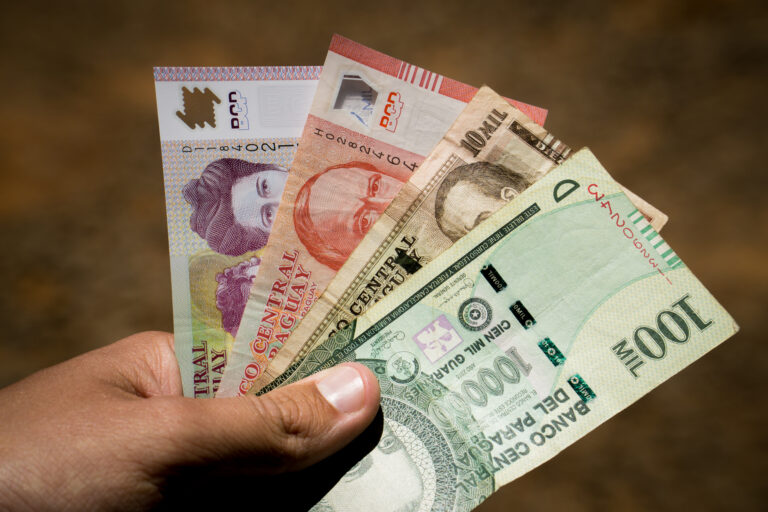The Paraguayan Guaraní (PYG) has been Paraguay’s official currency since 1944. Beyond serving as a medium of exchange, it reflects Paraguayan culture, history, and economic evolution. Whether you’re traveling to Paraguay, sending money there, or simply curious, this guide explores fascinating details about the currency and its significance.
What Are the Denominations of the Guaraní?
The Guaraní comes in both coins and banknotes. Currently, these denominations are available:
Banknotes
- ₲2,000
- ₲5,000
- ₲10,000
- ₲20,000
- ₲50,000
- ₲100,000
Coins
- ₲50, ₲100, ₲500, and ₲1,000 coins are no longer in circulation as of 2005.
Now, let’s uncover six interesting facts about the Guaraní.
6 Facts About the Paraguayan Guaraní
1. A Nod to Indigenous Heritage
The Guaraní currency is named after the Guaraní people, an indigenous group native to Paraguay, South Brazil, and Bolivia. Their language, also called Guaraní, is widely spoken in Paraguay and even holds official status alongside Spanish. Naming the currency after this group reflects Paraguay’s honor and integration of its cultural roots.
Did you know? “Paraguay” itself is a word of Guaraní origin, though historians debate its exact meaning.
2. Gold Still Plays a Role
While most modern currencies follow the fiat system, the Paraguayan Guaraní is partially backed by gold reserves. Approximately 5% of the country’s currency reserves consist of gold, maintaining a small link to a historical standard that most nations abandoned decades ago.
3. Its Birth Replaced the Peso
Before the Guaraní was introduced in 1944, Paraguay relied on the peso as its currency. Significant inflation destabilized the economy, prompting the government to transition to the Guaraní, exchanging one Guaraní for every 100 pesos. This marked an era of increased monetary stability, bolstered by Paraguay’s booming agricultural exports, particularly soybeans.
4. The Guaraní Has Its Precursor: The Real
Prior to the peso, Paraguay used the real as its currency until 1856. Initially introduced by Spain, the real circulated alongside the peso for decades until it lost its value completely. Paraguay’s eventual shift from the real to the peso reflected the nation’s move toward modernizing its economy post-independence.
5. Counterfeiting and Unofficial Circulation
Over the decades, Paraguay faced challenges with counterfeit Guaraní banknotes. A notable instance occurred in the early 2000s when unauthorized “2005” notes began circulating before their official release, leading to confusion.
To combat counterfeiting, the Banco Central del Paraguay introduced advanced security features in 2016, such as watermark technology and microtext. These updates have significantly reduced fraud and protected the integrity of Paraguayan money.
6. A New Currency Was Almost Introduced
The Guaraní holds the distinction of being the lowest-valued currency in the Americas. To address this, Paraguay’s government considered introducing the Nuevo Guaraní. Proposals included removing zeros from the existing notes and transitioning to a new system. However, concerns about potential confusion and logistical challenges led the government to preserve the Guaraní in its current form.
Paraguayan Guaraní Exchange Rates
The Guaraní’s exchange rate is significantly low compared to many global currencies. For example, during 2024, its value ranged between ₲7,252 and ₲7,790 for one U.S. dollar (USD). Exchange rates can fluctuate, so it’s essential to check a trusted money transfer provider like Remitly to ensure you get the most competitive rate.
FAQs
What is the Paraguayan Guaraní?
The Paraguayan Guaraní (PYG) is Paraguay’s official currency, introduced in 1944.
What denominations are available?
The Guaraní is available in banknotes (₲2,000–₲100,000) and coins, though smaller denominations like ₲50 and ₲100 coins have been phased out.
Where can I exchange Guaraní?
You can exchange Paraguayan currency at banks, currency exchange offices (casas de cambio), and airports in Paraguay as well as select international financial centers.
How much is $1 U.S. dollar in Guaraní?
The exchange rate for $1 USD to Guaraní varies but recently ranged from ₲7,252 to ₲7,790. Check the latest rates through Remitly or a trusted currency converter.
Can I use U.S. dollars in Paraguay?
While the Guaraní is the official currency, major hotels in the capital city of Asunción may accept U.S. dollars. However, carrying local currency is still recommended for purchases outside the city center.
Why isn’t céntimos used anymore?
Inflation rendered céntimos (coins worth 1/100 of a Guaraní) impractical for everyday transactions, leading to their phaseout.

